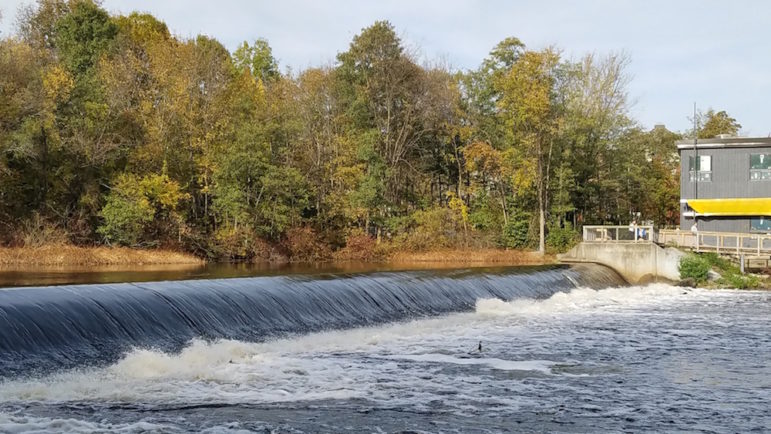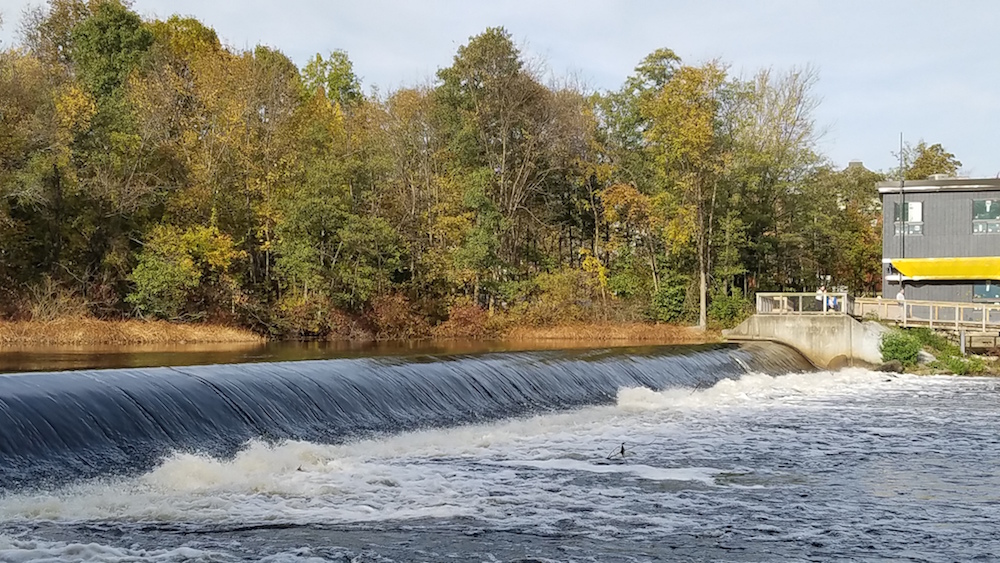
Charlie Breitrose
The Watertown Dam near Watertown Square slows the flow of the Charles River. A group is advocating removing the dam.
A short distance from Watertown Square the waters of the Charles River back up in a placid pool and then cascade several feet down into an area frequented by birds and other animals. This area, however, could be vastly changed if the Watertown Dam, which holds back the river, is removed as proposed by the Charles River Watershed Association (CWRA).
A dam was first built in the location in 1632 as a fish weir. The dam was rebuilt in 1962 after it suffered damage from flooding in 1918 and Hurricane Diane in 1955.
Earlier this month, Elisabeth Cianciola, aquatic scientist with the CWRA, spoke to the Conservation Commission about the possibility of removing the dam.
“There is no recognized use for the dam,” Cianciola said. “A study would see if there it may play a role in flood control.”
In December 2016, the Department of Fish and Game’s Division of Ecological Restoration (DER) announced that the Watertown Dam was added to list of provisional priority projects for dam removals. If the dam is put on the priority list it will be eligible to receive grants, project management and have contracted technical services funded, according to the DER website.
If the dam were to fail, Cianciola said, the waters released could cause major damage down stream.
The dam is one of 19 along the Charles River, but there have been efforts to remove as many dams as possible to return the river to its natural state. Last winter, a dam was removed from Bellingham, Cianciola said.
The move removal would also help the aquatic life in the Charles River, Cianciola said. The Watertown Dam is the first man made obstacle for migrating fish coming up the Charles River from the Boston Harbor. The Charles River Dam, at the mouth of the river, has a fish ladder which fish are able to get through, Cianciola said, but the one in Watertown is hard for the fish to navigate.
“About 80 percent of the fish, as they make their way past the dam, are consumed by birds,” Cianciola said.
Resident Russ Arico said he enjoys looking out over the dam at the wildlife and watching the birds catching fish. He did not like the idea of removing the dam, which he thinks of as a waterfall.
“It is an asset we have in town,” Arico said. “I don’t see the benefit of getting rid of it.”
Removing the dam would mean some major changes to the river in Watertown. Right now, water builds up behind the dam, and after it flows over the falls it trickles for a while before getting farther down stream. By removing the dam, the area west of the dam would no longer be filled with water, so the river level would be lower and the river channel in that location would be greatly narrowed. This may allow for more flood capacity.
“Water storage capacity may be expanded with the land exposed by the removal of the dam,” Cianciola said.
A study of the dam done by Stantec in 2011 found that there is some sediment buildup behind the dam, but it is not clear what is in the sediment.
“We need to find out what is the chemical composition to see if it may be harmful to wildlife or harmful to humans,” Cianciola said.
Before the dam is removed, a study would have to do to find out the impact of removing the dam, as well as to find out what is in the sediment behind the dam.
Conservation Commissioner Patrick Fairbairn said he was excited to here that there are efforts moving forward to remove the dam.
Commissioner Charles Bering said he has concerns about the impact of removing the dam. He remembers storm drains backing up in and popping off manhole covers in the same 2010 storm that broke away the old Watertown Dock.
“I am more of a skeptic,” Bering said. “What would it mean in extreme flood events?”
Cianciola has already spoken to the Watertown Stormwater Advisory Committee which said that removing the dam would lower the water level and expose the stormwater outflows, so there would be less chance of water backing up in the storm water system.
Commissioner Leo Martin is concerned about what grows up on the new land exposed if the dam is removed. He does not want to see invasive species growing along the banks of the river.
Once the study begins it will probably take a year or two to complete, Cianciola said, and it could find conditions that would prevent the removal of the dam.
“If there is no way to remove the dam and protect public safety it would not stop the project from moving forward,” Cianciola said. “Also, it could generate information that could cause the project to be delayed, such as if the cost estimate is really high.”
The DER has some funds set aside for set aside for the work, and the CWRA will look for federal money to to the work, Cianciola said.

I love the idea of removing the dam. We are having more and more high rains and this would offer protection against flooding. The river would look like miles of it upstream. It isn’t deep, but beautiful and interesting to see, coursing over rocks as it goes. It is delightful to sit at the river bank in Watertown and near Bridge Street, for instance. It is a regular running river and there is plenty of wildlife and birds. The fish ladder is astonishingly ineffective here and we should be protecting fish as an important contributor to ecological health. When the Alewife run, the birds will find them, but it would be spread out. And fishermen would be able to fish everywhere and not lie in wait at the fishladder. The river is such an important part of Watertown’s history and ecology–and recreation. We should do everything in our power to improve and protect it. Removing the dams, which serve no environmental purpose, is a good idea.